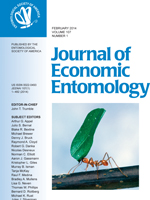Theory indicates that landscape composition affects transmission of vector-borne crop diseases, but few empirical studies have investigated how landscape composition affects plant disease epidemiology. Since 2006, Bemisia tabaci (Gennadius) has vectored the cucurbit yellow stunting disorder virus (CYSDV) to cantaloupe and honeydew melons (Cucumis melo L.) in the southwestern United States and northern Mexico, causing significant reductions in yield of fall melons and increased use of insecticides. Here, we show that a landscape-based approach allowing simultaneous assessment of impacts of local (i.e., planting date) and regional (i.e., landscape composition) factors provides valuable insights on how to reduce crop disease risks. Specifically, we found that planting fall melon fields early in the growing season, eliminating plants germinating from seeds produced by spring melons after harvest, and planting fall melon fields away from cotton and spring melon fields may significantly reduce the incidence of CYSDV infection in fall melons. Because the largest scale of significance of the positive association between abundance of cotton and spring melon fields and CYSDV incidence was 1,750 and 3,000 m, respectively, reducing areas of cotton and spring melon fields within these distances from fall melon fields may decrease CYSDV incidence. Our results indicate that landscape-based studies will be fruitful to alleviate limitations imposed on crop production by vector-borne diseases.
How to translate text using browser tools
1 February 2014
Assessing Transmission of Crop Diseases by Insect Vectors in a Landscape Context
Y. Carrière,
B. Degain,
K. A. Hartfield,
K. D. Nolte,
S. E. Marsh,
C. Ellers-Kirk,
W.J.D. Van Leeuwen,
L. Liesner,
P. Dutilleul,
J. C. Palumbo
ACCESS THE FULL ARTICLE
It is not available for individual sale.
This article is only available to subscribers.
It is not available for individual sale.
It is not available for individual sale.
Bemisia tabaci
Classification and Regression Tree
cucurbit yellow stunting disorder virus
integrated pest management
landscape ecology





